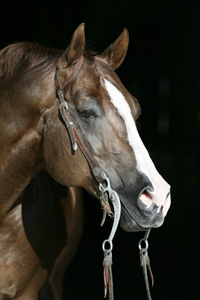Dickson Varner DVM, Professor of Theriogenology at Texas A&M University and a world-renowned expert on stallion reproduction, has developed a technique to improve low fertility rates in stallions. The process is beneficial in a variety of situations, but especially for established aging sires, whose owners are often reluctant to talk publicly about the problem.
 Not so with the connections of Dual Pep, a cornerstone of the cutting horse industry. When Dual Pep, an all-time leading sire, maternal grandsire, and paternal grandsire, began to show signs of diminished fertility, the 23-year-old stallion’s owner, Bobby Pidgeon, connected with Dr. Varner and his associate, David Hartman DVM, to remedy the problem.
Not so with the connections of Dual Pep, a cornerstone of the cutting horse industry. When Dual Pep, an all-time leading sire, maternal grandsire, and paternal grandsire, began to show signs of diminished fertility, the 23-year-old stallion’s owner, Bobby Pidgeon, connected with Dr. Varner and his associate, David Hartman DVM, to remedy the problem.
“All stallions, if they live to be old enough, are going to experience fertility problems as a result of semen quality deterioration,” said Varner. “It’s not unique to Dual Pep. He’s just an old man. Fortunately, with this technique, we’re able to prolong the productive breeding life of a stallion.”
Varner and his associates worked with the company that produces PureSperm for use in human in vitro insemination, to perfect the equine equivalent.
“Men are generally quite sub-fertile in comparison with other species,” noted Varner. “A stallion is similar to a man in that they are not selected as sires based on reproductive parameters of semen quality. Agricultural animals are typically not sires if they do not have good semen quality. But stallions are selected as sires based on performance record, pedigree and conformation.”
The relatively new technique developed by Varner and his team has been used successfully on a number of high-profile race and performance stallions in the US and abroad. The results of Dual Pep’s trial breedings in 2008 were so encouraging that he is slated to stand at Hartman Equine Reproduction Center in 2009, where Dr. Hartman will oversee the procedure.
“Typically, a stallion has a per-cycle pregnancy rate in the 60 percent range,” Varner explained. “Right now, Dual Pep looks like he’s sitting at about a 75 percent per cycle rate. That’s an outstanding number, even for a young horse.”
Varner and his team are currently the only equine specialists who perform the procedure. “It requires a special insemination technique,” he explained. “Typically mares are bred with half of a cc of semen that has to be placed in a specific location in the uterus.
“The mares need to be transported to the stallion and stay through the cycle. If the semen were shipped to somebody with no familiarity with the technique, I expect the results would be poor.”
Hartman, an adjunct professor of theriogenology at Texas A&M, has a busy private practice with a large herd of recipient mares. As a reproductive specialist, he serves many of North Texas’s top stallion farms, and has not been interested in operating a breeding facility of his own.
“I’m not in the stallion standing business, but when this situation arose and they asked me, I agreed,” he said. “It is extensively time consuming procedure, but Dual Pep is a special horse that I would like to do good for. Even though the world is full of sub-fertile stallions, not many of them are of the quality to warrant this procedure.
Like Varner, Hartman, was impressed with the breeding trials conducted with Dual Pep in 2008. “After he did well on recipient mares, we bred four mares that were open because they didn’t get bred in 2008 and we got three in foal on the first cycle,” he pointed out.
“By definition, recipient mares are reproductively sound. So doing well on a bunch of young recipient mares is not the same as doing well on older open mares, such as you might see during the breeding season.”
Dual Pep, whose sons and daughters have earned over $20 million, is at home at Bar H Ranche, Weatherford, Texas, with stablemate and top sire CD Olena, during the off season. Both stallions will be stabled on Stallion Alley at the NCHA Futurity in Fort Worth during Super Stallion Weekend, on December 13 and 14, after which time, CD Olena will join Dual Pep for the 2009 breeding season at Hartman Reproduction Center.
